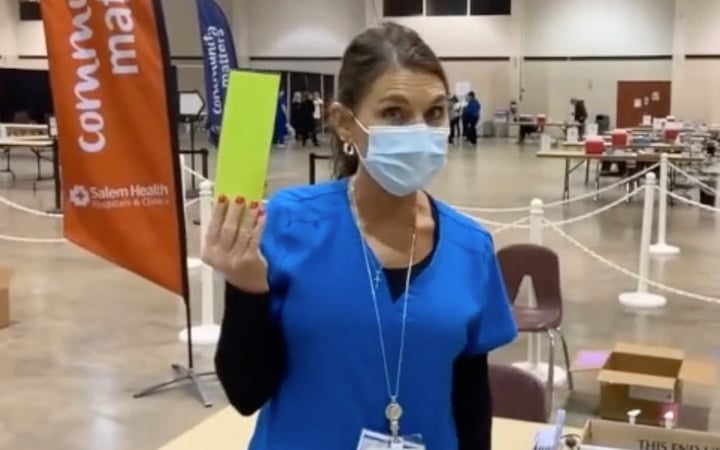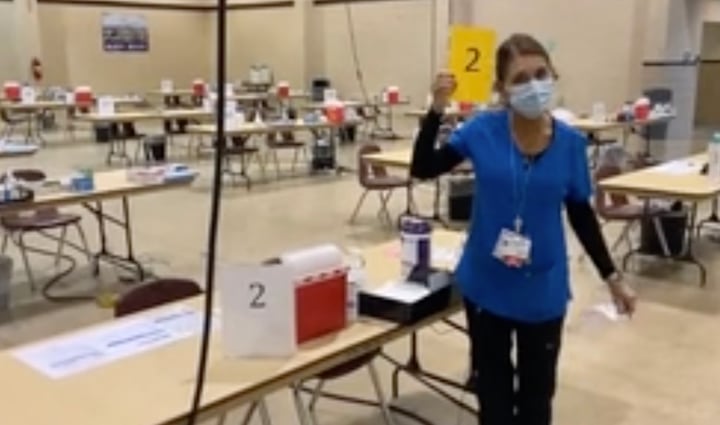Thanks to Catalysis for sharing this webinar presentation by Erica Randall, Director of Continuous Improvement, and Pam Reznicsek, Kaizen Learning and Development Consultant at Salem Health. You can view it below:
Another Upcoming Webinar
Before I share some notes from the video, I want to mention that Catalysis is co-sponsoring an upcoming webinar panel discussion on the subject, hosted by KaiNexus. It's free and you can register here (or watch the recording after the 21st):
Improving the COVID Vaccination Process: Lessons from the Field
I hope you'll be able to join us.
Now, on to notes from the presentation....
Goals and Actuals for Oregon and Salem Health
This is all very recent, as they became a distributor for the vaccines on December 31st. Their problem statement includes a gap between the current state and the goal, at the state level:
CURRENT STATE = 4,300 vaccinations a day
GOVERNOR'S GOAL = 12,000 vaccinations a day
For context, Oregon has a population of over four million people, so at that rate, it would take almost an entire year to vaccine everybody.
In my view, closing that gap requires:
- Having enough vaccine
- Having enough providers to administer it in a timely way
- Having the patients there to be vaccinated (the right people at the right time)
#1 might be out of the control of a health system, but it seems like they could do work on #2 and #3 -- planning, training, communicating, etc.
Beyond the Salem Health hospitals and clinics, they opened up two vaccine clinics at two different fairgrounds sites in the first two weeks of January.
Back to #1, vaccine availability did become an issue, as they had to shut down for a day and a half because they ran out of vaccine.
Erica shared some stats:
They vaccinated over 3,500 people in the first two days
They've been exceeding their target of 2,000 people per day
They increased the patients per hour from 250 to 410 in two days
Their goal is now 3,000 vaccinations a day.
Doing the math, 410 times 8 is about 3,000, so I wonder if the amount of vaccine is the bottleneck (since this could run as a 24/7 operation if you had proper staffing).
Every Person is a Problem Solver
While Erica mentioned a "command center structure," she mentioned their Lean program of recent years and how they aim to have every person be a problem solver. That's great!
She attributes the increase in the hourly rate related to everybody being empowered to speak up when they see a problem.
Patient Flow
They've focused some of that problem solving on flow, as to avoid patients having to wait outside in the Oregon rain. Erica reports that the time elapsed from parking to then being in the area waiting and being monitored to see if there is a reaction was only about 15 minutes.
Staff Roles
Erica described "stationed" roles and "roaming" roles (meaning they roam and check or help with different things).
| Stationed Roles | Roaming Roles |
| Parking | Site leader |
| Screener | Clinical leader |
| Registration / Pre-Check Rep | Vaccine Prep lead |
| Vaccine prep | Supervising Provider |
| Vaccinator | |
| Post-Vaccine clinic monitor | |
| Supply coordinator | |
| EVS / Bio pickup | |
| Security |
Erica talked about staff flagging problems (Toyota would use the phrase "pulling the andon cord") to get the site leader or others to help. That's great to see. The key to any effective "andon" process, of course, is getting a very fast response from somebody who can help investigate (a manager or other leader).
The Flow of Supplies
One problem that Erica mentioned was something that's created by the common realization that you can sometimes get six full doses from a Pfizer vaccine vial instead of the intended five (due to "overfill"). That means they need to then get more syringes and needles if they get more doses than they planned for.
One thought that comes to mind for me is that needles and syringes are inexpensive and small. I would be curious about setting up a "two-bin kanban system" where we err on the side of "too much" inventory of supplies (and it's not like these materials expire). I'd hate to have the precious vaccine (which has a ticking clock for use once it's thawed) be delayed or potentially wasted due to not having an abundance of syringes and needles ready.
With a two-bin system, you could build in the assumption that each vial contains six doses and have supplies on hand accordingly. It's better to err on the side of "a little too much" rather than "not quite enough," again especially when items are small and cheap.
Don't confuse "just in time" inventory with "cutting it too close." We should have enough inventory on hand to maintain the flow of vaccines and patients. Again, keeping the flow going is more important than low inventory.
The Flow of Patients
Erica showed illustrations of the high-level fairground flow (driving in and driving out) and the flow within the building. Erica also mentioned the need to have a "fast pass" approach for patients with special needs.
In this discussion, Erica mentioned their use of Plan Do Check Adjust cycles and said that "they'd still be planning" if they didn't have the ability to Check and Adjust (which, to me, comes back to engaging everybody in problem solving).
Erica shared this video within her webinar:
It's interesting that there seem to be two distinct physical patient flows -- one for those who registered electronically and those who registered using a more paper-based system (and registration needs to be completed there on site).
A patient is given a green "visibility card" to let them know they are ready to approach the registration table. That seems like a form of visual management - hopefully the meaning of that card is communicated clearly.

After registration, the patient moves to the vaccination line.
Vaccine Preparation
The vaccine prep is done by "qualified individuals" and I notice it's being done out on the main floor. I've heard of one hospital that's drawing syringes in the pharmacy, under a hood, and that creates longer transportation delays to get syringes to the point of injection. The hospital leader I talked to was investigating why that was being done in the pharmacy. I think "ideal care" would have the syringes drawn up very close to the patient -- improving flow and reducing the risk of delays.
Vaccination Stations and Beyond
There is a person who directs patients from the line to vaccination tables. The vaccinator at the table hold up a yellow card to indicate they are ready.

If the vaccinator needs more supplies at their station, they hold up a light blue card, which serves as a pull signal. I wonder if there is risk that multiple stations need supplies at the same time?
This could, again, be addressed, with a two-bin kanban system or something that is a little bit more proactively planned out.
When does the vaccinator call for more supplies? Hopefully not when they run out. I'd assume that is not the case here given their Lean experience at Salem Health.
The beauty of a two-bin kanban system is that the replenishment signal is sent when there is approximately one half of the needed supply left.
Even with all of those tables, most supplies that are needed for vaccination are small and inexpensive. It's important to make sure you have enough inventory so that the precious vaccine can be used most effectively. The flow of vaccine to the tables is the thing that would probably have to be managed most tightly.
There is also a pink card that calls for the medical lead to come over to talk with the patient in the event there are questions or concerns.
The patient is told if they need to wait 15 or 30 minutes and they get a color-coded sticker placed on their shirt (with the time they are able to leave) -- another form of visual management for the next step in the process -- the post-vaccine monitoring area, with appropriately distanced chairs.
The leader in the video mentions their "Lean methodology" and the ability to adjust, which is great.
The Mindset of Leaders and Standardized Work
Erica said it "warmed her heart" to see how much visual management there was in the video, as evidence of Lean thinking being embedded in their leaders and the way they do things -- developing leaders and front-line staff is something they're rightfully proud of.
Pam, who works in their "Kaizen Promotion Office," spoke next, and she talked through some other details of their process, including some other examples of visual management and standardized work.
She mentioned managers observing "the flow of the work" -- something I think is a very important part of any process. Managers should be helping, not judging, to see if people are able to do the right work the right way, helping to remove systemic barriers that get in the way.
Talking about supplies, Pam mentioned the Lean "water spider concept" -- in my experience, these would be planned routes (as I mentioned earlier), which is better than reacting to a bunch of pull signals from vaccination tables during the day.
The routes for picking up full sharps containers could also be on a planned interval (if you know how many vaccines you can give per hour, you know how long it should take for the sharps container to fill up). Each station could have two sharps containers... when one is full, you have a second one to use while you're waiting for the water spider to come. These sharps containers aren't very large (and the tables being used here are large, so it looks like there would be room).
Lessons Learned
They've had to shut down the clinic at times due to vaccine availability. What they call "flexing," I would call "closing early and sending people home early."
They've also learned there is a risk that the patient loses their vaccine record card, so they've reminded patients to take a photo of their card.
Thanks
Thanks to Salem Health, and to Erica and Pam for sharing with us all!
Let Us Help You
Value Capture would love to help you and your organization with the vaccination process. You can contact us if you'd like to have a discussion about your needs.

Written by Mark Graban
Mark Graban has served healthcare clients since 2005. Mark is internationally recognized as a leading author and speaker on Lean healthcare. His latest book is "The Mistakes That Make Us: Cultivating a Culture of Learning and Innovation."

Submit a comment